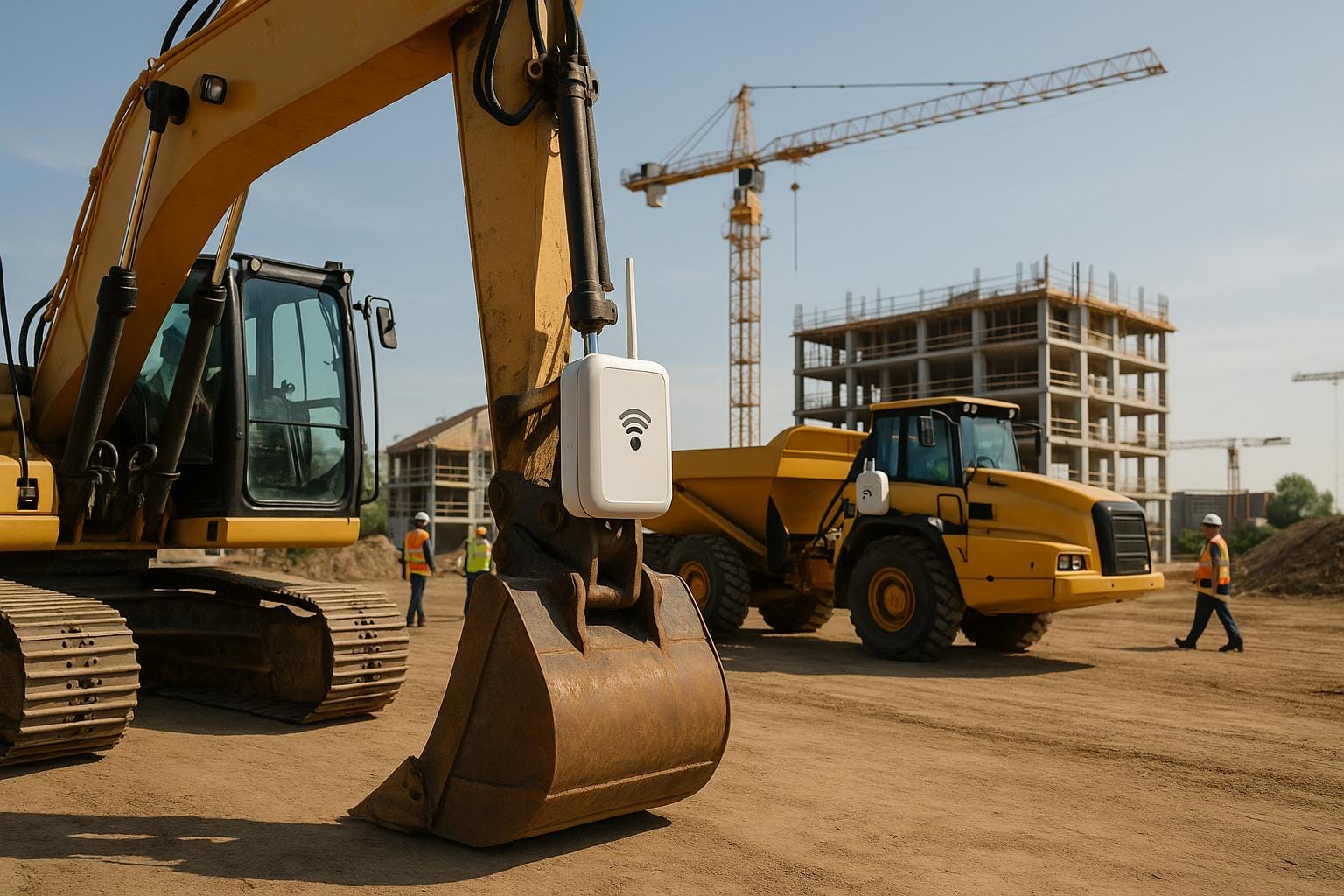Environmental Sensors for Construction Fleets
Explore how environmental sensors enhance construction fleet efficiency, protect equipment, and ensure compliance with UK regulations.

Environmental sensors have become an important tool for UK construction fleets. They help protect equipment, improve efficiency, and ensure compliance with strict regulations. By monitoring factors like air quality, noise, and vibration, these sensors help companies avoid costly fines, project delays, and reputational damage.
Key benefits include:
- Equipment Protection: Sensors track temperature, humidity, and weather changes to prevent damage.
- Efficiency Gains: Real-time data improves scheduling, reduces downtime, and cuts fuel use.
- Regulatory Compliance: Monitoring dust, noise, and vibration ensures adherence to UK laws like the Environmental Protection Act 1990.
When integrated with telematics systems, sensors provide even greater value. For just £7.99 per vehicle per month, platforms like GRS Fleet Telematics combine environmental monitoring with advanced fleet management tools. This integration reduces costs, improves safety, and helps businesses meet net-zero targets.
Despite challenges like sensor maintenance and data management, the benefits often outweigh the difficulties, making these technologies a smart investment for construction firms.
Building Smarter: IoT Revolutionizes Construction Sites
1. Monitoring Sensors
Monitoring sensors are game-changers when it comes to protecting equipment, improving efficiency, and meeting regulatory standards. These devices keep a constant eye on critical environmental factors, ensuring construction fleets stay operational and assets are well-maintained.
Equipment Protection
Construction equipment is constantly at risk from environmental factors like sudden temperature shifts, high humidity, extreme weather, strong winds, and moisture. These conditions can lead to rust, damage sensitive electronics, and even ruin materials stored on-site - problems that are both costly and time-consuming to fix.
"Sensors detect temperature changes, humidity changes, and other minute environmental changes that put valuable equipment and materials at risk."
– Eyrus
Environmental sensors and weather stations allow construction teams to monitor conditions in real time and take preventive actions to avoid damage. For example, AEM operates a vast weather network with 12,000 neighbourhood-level sensors, offering precise, localised data to help managers make informed decisions about asset protection.
Early warning systems are another critical tool. These systems alert teams to severe weather, giving them time to secure equipment, cover materials, or pause operations if needed. When combined with resource planning, weather data can also help optimise material deliveries, reducing spoilage and ensuring projects stay on track. This proactive approach not only safeguards equipment but also lays the groundwork for smoother operations.
Efficiency
Monitoring sensors do more than just protect assets - they also drive operational improvements. By tracking equipment health and environmental conditions in real time, sensors enable better coordination, scheduling, and even predictive maintenance.
McKinsey & Company estimates IoT solutions could add between £55 billion and £425 billion in economic value annually by 2030 within the construction sector.
"We estimate that operators can increase throughput by 5 to 10 percent, reduce raw material cost by 5 to 9 percent, and improve personnel efficiency by 7 to 15 percent."
– McKinsey & Company
Smart sensors and tracking systems ensure tools are available when needed, reduce delays, and enable predictive maintenance, which can cut downtime by 25–30% and improve asset utilisation by 10–15% . Considering that up to 35% of construction time is spent on non-productive tasks like waiting for equipment or fixing errors, these efficiency gains are substantial.
Regulatory Compliance
In the UK, environmental sensors play a vital role in helping construction projects meet strict regulations. Monitoring dust, noise, and vibrations ensures contractors stay within legal limits while minimising the impact on surrounding areas .
"Environmental monitoring in construction provides essential measurement and analysis of environmental conditions, both on and around work sites. Monitoring and managing the levels of environmental impact can help contractors and customers minimise environmental impact and comply with environmental regulations."
– Mabey Hire
Construction sites generate pollutants like dust, which can harm air quality for workers and nearby communities. Noise can cause hearing damage and disrupt wildlife, while vibrations from heavy machinery may damage nearby buildings or disturb residents. Local councils often enforce specific guidelines, such as Supplementary Planning Guidance (SPG8), for monitoring and reporting dust levels.
For example, during the demolition of Fiddler's Ferry power station in Warrington, P.P. O'Connor used Mabey Hire's environmental monitoring solutions to protect nearby residential areas and infrastructure. Non-compliance with these regulations can lead to severe penalties, including permit suspension or cancellation by the Environment Agency. Continuous monitoring is, therefore, not just about meeting legal requirements - it’s essential for maintaining business operations.
Integration with Telematics
The benefits of monitoring sensors are amplified when their data is integrated with telematics systems. This creates a unified approach to managing construction fleets, combining equipment protection, efficiency, and compliance into one seamless strategy.
IoT sensors automate data collection and analysis, delivering real-time insights that help project managers optimise schedules and allocate resources effectively. Reliable connectivity ensures that this data flows smoothly from the site to decision-makers.
To make the most of these systems, companies need well-thought-out monitoring plans. These should identify the key environmental factors to track, set appropriate monitoring intervals, and establish clear methods for data collection and analysis. Importantly, the data should feed directly into project management decisions, ensuring environmental considerations influence day-to-day operations.
2. GRS Fleet Telematics

GRS Fleet Telematics combines environmental sensors with tracking technology to safeguard assets and improve efficiency. Starting at just £7.99 per vehicle per month, this platform merges real-time environmental monitoring with advanced fleet management tools.
Equipment Protection
The system’s sensors provide real-time monitoring of temperature and humidity, supporting up to six independent readings per asset gateway. Alerts are sent when conditions fall outside set parameters, helping to protect sensitive materials like concrete additives, adhesives, or electronic components that require specific storage conditions.
These sensors are compatible with all reefer makes and models, so there’s no need for manufacturer-specific add-ons. Additionally, the system’s smart sensors can detect extreme environmental conditions, such as excessive heat, and notify management immediately. This enables faster responses, reducing risks to equipment and improving workplace safety.
By preventing environmental damage and minimising unplanned downtime, these measures also contribute to smoother operations.
Efficiency
Integrating environmental sensors with GRS Fleet Telematics delivers efficiency gains for construction fleets. The Internet of Things (IoT)-enabled platform optimises routes, fuel consumption, and maintenance schedules.
With real-time environmental data, fleet managers can make better-informed decisions about equipment deployment. For instance, if sensors detect adverse conditions at a site, resources can be redirected to more suitable locations, ensuring productivity while protecting assets.
The system also supports predictive maintenance. By analysing environmental conditions alongside equipment performance, potential issues can be identified and addressed before they lead to costly breakdowns, reducing downtime.
Regulatory Compliance
GRS Fleet Telematics simplifies compliance with strict UK regulations through continuous monitoring and automated tracking features.
The UK Environmental Policy 2025 has introduced tougher carbon emission reduction targets and stricter regulations for businesses. Companies failing to meet net-zero emission goals face higher fines and operational restrictions. With real-time monitoring and automated reporting, GRS Fleet Telematics helps construction firms maintain detailed records, ensuring compliance with policies like the Streamlined Energy and Carbon Reporting (SECR) framework.
Looking ahead, the UK Carbon Border Adjustment Mechanism (CBAM), set to launch on 1 January 2027, will impose carbon costs on high-emission materials such as cement, steel, and aluminium. By providing robust environmental monitoring, GRS Fleet Telematics positions construction businesses to adapt to these changing regulations.
This compliance capability integrates seamlessly with broader fleet management strategies.
Integration with Telematics
GRS Fleet Telematics combines environmental monitoring with advanced fleet management in a single platform. It tracks factors like light levels, CO₂ levels, temperature (both indoors and outdoors), wind, and sunlight to ensure efficient environmental control.
This integration enhances the platform’s utility by merging sensor data with tracking capabilities, enabling more informed operational decisions. With its open API architecture, the system allows construction companies to incorporate sensor data into their existing project management tools, ensuring environmental insights are directly tied to planning and decision-making.
Real-time data also helps fleets adapt to current road and traffic conditions while factoring in environmental variables. This comprehensive approach ensures that environmental factors are considered in every operational decision.
Pros and Cons
The combination of environmental sensors and telematics offers construction fleets a range of benefits, but it also comes with its share of challenges. By weighing the pros and cons, fleet managers can better evaluate whether these technologies align with their operational goals and resources.
| Aspect | Advantages | Limitations |
|---|---|---|
| Equipment Protection | Real-time monitoring reduces equipment damage, cutting downtime by 25–30% | Sensor performance may decline in harsh conditions, requiring regular calibration. Variability between sensors can also impact reliability |
| Operational Efficiency | Energy use can drop by up to 47% through optimised lighting, HVAC systems can become 30% more efficient, and journey times may decrease by 15% | Handling diverse streams of sensor data is complex and demands advanced analytics |
| Regulatory Compliance | Automated record-keeping simplifies adherence to DVSA requirements | Issues around data ownership, privacy, and security need to be addressed |
| Safety Management | Improved air quality monitoring has led to a 15% reduction in work-related illnesses, and sensors can detect hazardous gases early | Remote sites may face connectivity issues, and isolated sensors often struggle with consistent power supply |
The financial upside is hard to ignore. Predictive maintenance, powered by sensor data, has shown impressive results, with 94% of businesses reporting a positive return on investment. For instance, a logistics company in Manchester saved around £100,000 annually, while a London-based courier firm cut costs by £75,000 through telematics-enabled route planning and fuel management.
However, the technical hurdles can’t be overlooked. Environmental factors often affect sensor accuracy, making regular calibration crucial to maintain reliable data. Additionally, the sheer amount of data generated by various sensor types requires robust management platforms and skilled personnel to interpret and act on the information.
Another key challenge is lack of standardisation. Sensors from different manufacturers can struggle to integrate, creating data silos that limit a fleet’s ability to perform comprehensive analyses.
Security is also a pressing concern. Sensors scattered across construction sites are vulnerable to physical tampering and cyberattacks, making strong security protocols essential. Moreover, the energy demands of these systems can sometimes undermine their intended environmental benefits if not carefully managed.
Despite these obstacles, the advantages often outweigh the difficulties. Platforms like GRS Fleet Telematics address many of these issues by offering an all-in-one solution. At just £7.99 per vehicle per month, their system integrates environmental monitoring with proven tracking technology. It works across various equipment types and provides tools to turn raw data into actionable insights, tackling interoperability concerns head-on.
Success with these technologies depends on planning and preparation. Fleet managers need to invest in reliable IoT infrastructure and develop strong data analytics capabilities to fully leverage environmental sensors. By doing this, they can achieve measurable gains in equipment protection, operational efficiency, and compliance. Solutions like GRS Fleet Telematics demonstrate how integrated approaches can streamline operations while safeguarding equipment and improving overall fleet performance.
Conclusion
The combination of environmental sensors and telematics presents a game-changing opportunity for UK construction companies. These tools not only boost fleet performance but also help businesses navigate strict environmental regulations. The data speaks for itself: integrating these technologies can drive improvements across various operational areas.
The financial benefits are equally compelling. Telematics has been shown to cut costs in multiple areas: fuel by 22%, accidents by 20%, labour by 20%, maintenance by 14%, and insurance by 22%. One notable example saw a fleet save £650,000 annually just by reducing idle time.
Environmental compliance is no longer optional for UK construction firms. With the government’s legal commitment to achieving net-zero emissions by 2050, businesses are under growing pressure from both customers and shareholders to minimise their carbon footprint. Telematics provides the data needed to make smarter decisions, leading to lower emissions and better fuel efficiency. As Mike Granruth from Trimble explains:
"By leveraging telematics, nonproductive idling could be reduced by 10-15%, on average."
This reduction in idle time not only cuts emissions but also saves money. Additionally, telematics plays a critical role in improving safety. In 2021, commercial vehicles were involved in more serious and fatal accidents per mile than any other transport type. Real-time compliance monitoring through telematics helps fleet operators maintain safer, law-abiding operations, reducing risks, fines, and penalties.
For construction companies ready to adopt these technologies, the advice is straightforward: opt for an integrated solution. Instead of deploying sensors and telematics separately, choose systems that combine environmental monitoring with proven tracking capabilities. GRS Fleet Telematics is a great example, offering a comprehensive package for just £7.99 per vehicle per month. Their dual-tracker technology achieves a 91% recovery rate for stolen vehicles, making it a smart investment.
However, success isn’t just about installing new tech. Companies need to ensure their teams are trained to interpret and act on the insights generated by IoT and telematics systems. Fleet managers can use this data to coach operators on fuel-saving techniques and implement targeted improvements in real time. By taking this integrated and informed approach, construction companies can maximise the benefits of telematics while meeting environmental and safety goals.
FAQs
How do environmental sensors help construction fleets meet net-zero targets?
Environmental sensors are key tools for construction fleets aiming to reach net-zero goals. These devices provide real-time insights into factors like air quality, temperature, and emissions. With this information, fleet managers can make smarter decisions to cut energy use, lower fuel consumption, and reduce carbon emissions.
By enabling more efficient operations and helping fleets meet environmental regulations, these sensors play a vital role in cutting greenhouse gas emissions. They also help spot and address potential environmental risks, making them indispensable for fleets dedicated to sustainability and reducing their carbon footprint.
What challenges do construction fleets face with environmental sensors, and how can they overcome them?
Environmental sensors used in construction fleets often face tough challenges. Dust, constant vibrations, extreme temperatures, and moisture can all take a toll, affecting sensor accuracy, causing malfunctions, and even leading to wear and tear over time. This can result in downtime and unreliable data, which no one wants.
The solution? Invest in rugged, weather-resistant sensors built to withstand these harsh conditions. Pair this with regular calibration and maintenance to keep them performing reliably. Another smart move is to use modular IoT systems. These allow for easier maintenance, quick sensor replacements, and minimal disruptions, helping to keep your operations smooth while extending the life of your equipment.
How do environmental sensors combined with telematics improve construction fleet management?
Integrating environmental sensors with telematics systems has reshaped construction fleet management. It provides real-time updates on site conditions, equipment performance, and potential risks, leading to improved safety, reduced downtime, and adherence to environmental regulations.
By remotely tracking factors like temperature, humidity, and air quality, fleet managers can make informed decisions to maintain equipment effectively, use fuel more efficiently, and cut emissions. This approach not only supports efforts to operate more responsibly but also helps businesses save on costs while running their operations more smoothly in the construction industry.
